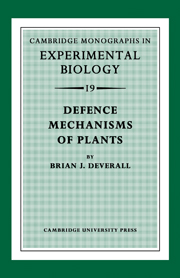Book contents
- Frontmatter
- Contents
- Preface
- 1 INTRODUCTION TO THE HOST–PARASITE INTERACTION
- 2 DISCRIMINATORY EVENTS BEFORE AND DURING PENETRATION INTO PLANTS
- 3 CYTOLOGICAL CHANGES IN HOST AND PARASITE AFTER INFECTION
- 4 CROSS-PROTECTION AND INDUCED RESISTANCE
- 5 PHYTOALEXINS AND THEIR INDUCED FORMATION AND BIOSYNTHESIS
- 6 ROLE OF PHYTOALEXINS IN DEFENCE MECHANISMS
- 7 MEDIATION OF HOST–PARASITE SPECIFICITY
- References
- Index
3 - CYTOLOGICAL CHANGES IN HOST AND PARASITE AFTER INFECTION
Published online by Cambridge University Press: 10 May 2010
- Frontmatter
- Contents
- Preface
- 1 INTRODUCTION TO THE HOST–PARASITE INTERACTION
- 2 DISCRIMINATORY EVENTS BEFORE AND DURING PENETRATION INTO PLANTS
- 3 CYTOLOGICAL CHANGES IN HOST AND PARASITE AFTER INFECTION
- 4 CROSS-PROTECTION AND INDUCED RESISTANCE
- 5 PHYTOALEXINS AND THEIR INDUCED FORMATION AND BIOSYNTHESIS
- 6 ROLE OF PHYTOALEXINS IN DEFENCE MECHANISMS
- 7 MEDIATION OF HOST–PARASITE SPECIFICITY
- References
- Index
Summary
It must be clear from the previous chapter that the fate of most potential parasites is decided after they have entered their host plants. It is important, therefore, to know the location of parasites within and between cells, the stages during attempted infection when parasitism succeeds or fails, and the associated responses of host cells as revealed by light and electron microscopy. Based on this knowledge, the significance of the numerous physiological and biochemical changes in infected plants to the processes of resistance and susceptibility can be assessed.
THE CELLULAR LOCATION OF PARASITES IN HOST TISSUES
There have been a limited number of quantitative studies on related cytological changes in host and parasite during the critical stages when resistance is expressed or parasitism is established. Before considering these studies which are confined to a few much analysed host–parasite relationships, it is valuable to review the different ecological niches presented by plants and the ways in which they are exploited by specialized microorganisms. In doing so, it is well to emphasize the types of physiological interaction which might be anticipated between the cells of parasite and host, and to appreciate the rarity of direct contact of the protoplasts of the two organisms. The parasitic protoplast is usually separated by its cell wall from the host, and in many cases a host cell wall also separates the two protoplasts.
- Type
- Chapter
- Information
- Defence Mechanisms of Plants , pp. 18 - 29Publisher: Cambridge University PressPrint publication year: 1977



